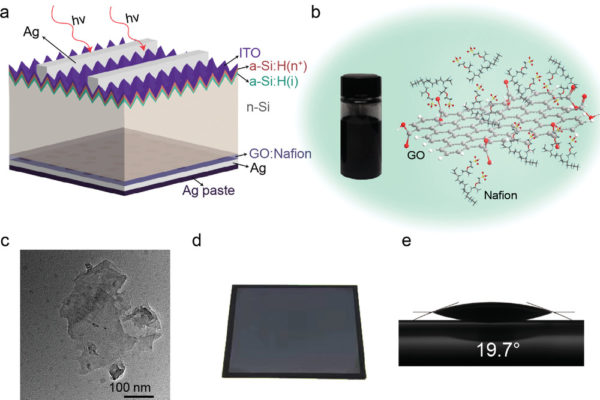An international research group has unveiled a heterojunction solar cell based on graphene-oxide (GO) and silicon with a large area of 5.5 cm2.
GO is a compound of carbon, oxygen and hydrogen that is obtained by treating graphite with oxidizers and acids. It consists of a single-layer sheet of graphite oxide that is commonly used to produce graphene-family nanomaterials for various applications, including electronics, optics, chemistry and energy storage.
The scientists developed an ink of GO mixed with Nafion that can be spin-coated on an n-type silicon wafer to form a high-quality passivating contact scheme. “Low interface recombination is provided by the Nafion and carrier selection by the GO,” they explained, noting that the passivation scheme also includes an electron-selective passivation contact comprising n-doped hydrogenated amorphous silicon with an indium tin oxide (ITO) overlayer aimed at improving light trapping and reducing surface recombination.

Image: Hebei University, Advanced Materials Interfaces, Creative Commons License CC BY 4.0
“Graphene was also shear force mixed in Nafion at a concentration of 8 mg mL–1,” they further explained. “Either of these inks were then spin-coated onto the back of the Si wafer, a thin film of Ag was evaporated on top of this and finally an electrical Ag paste was applied for encapsulation and to block the ingress of small quantities of water. Atomic force microscopy (AFM) revealed that the GO:Nafion layers completely covered the Si surface and a root mean roughness of 89 nm was recorded.”
Popular content
According to the researchers, the GO:Nafion layer simultaneously creates a p–n junction with silicon and passivates the surface defects at the GO:Si interface. The graphene-silicon solar cell is reportedly able to achieve a power conversion efficiency of 18.8%. “Pseudo J–V curve shows a pseudo fill factor of 80.6% without the serious resistance effect, and potentially predicts that an efficiency of 21.59% could be achieved with further optimization.”
They presented the solar cell in the paper “High-Efficiency Graphene-Oxide/Silicon Solar Cells with an Organic-Passivated Interface,” published in Advanced Materials Interfaces. The research team comprises academics from the Karlsruhe Institute of Technology (KIT) in Germany, the Hebei University in China, and Chinese module manufacturer Yingli Green Energy Holding Co., Ltd. “The scalable fabrication and good wettability of the GO:Nafion ink provides a favorable direction toward development of carbon-based PV in the future,” they concluded.
This content is protected by copyright and may not be reused. If you want to cooperate with us and would like to reuse some of our content, please contact: editors@pv-magazine.com.



Graphene solar cells
Graphene Solar Cells are interesting.